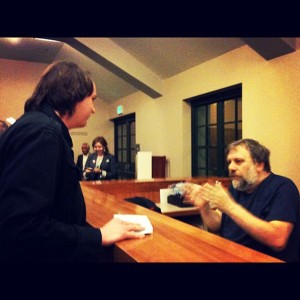Here are a few thoughts I’ve recently had on Kant. He’s starting to become a larger figure in my thesis, so I’ve been tackling the Prolegomena as well as some secondary literature surrounding the central claims in his transcendental system, particularly those dealing with the imagination…
For Kant, objects of experience are ‘in’ space and time. Space and time are the a priori forms of sensible intuition. They are the ‘formal’ conditions that enable cognition to experience objects. Sensible objects thus accord with the principles of intuition in that the latter prescribe the principles of the former upon them.
There is an immediate aporia that arises with Kant’s assertion that objects of experience are ‘in’ space and time. It has to do with language; specifically the use of the preposition ‘in’. It might be that Kant was merely running up against the limits of language. But nevertheless, the point remains that his choice to employ a spatial metaphor has far-reaching implications, whether intended or not.
For Kant, the assertion that space and time are the only forms of possible intuition is a basic fact that he remarks must be accepted as ‘just so’. As he remarks in Prolegomena to Any Future Metaphysics, “During an investigation of the pure elements of human cognition (containing nothing empirical), I first succeeded after long reflection to distinguish and separate with reliability the pure elementary concepts of sensibility (space and time) from those of the understanding [emphasis added]” (§39). This assertion is found in the “Appendix” to the “Main Transcendental Question, Second Part,” addressing the possibility of a pure natural science, and it is regarded as a basic fact that is incapable of further explanation (see CPR, B 145-146). In this section of the Prolegomena, Kant sets forth what he sees as one of the most crucial questions for transcendental philosophy: “How is nature itself possible” (§36)? To answer this question, Kant believes that two elucidating questions first need to be addressed: (1) how is nature materially possible? and (2) how is nature formally possible? Kant answers the first thusly:
[Nature is materially possible] by means of the constitution of our sensibility, in accordance with which our sensibility is affected in its characteristic way by objects that are in themselves unknown to it and that are wholly distinct from said appearances (§36)
His answer to the second question is that
[Nature] is possible [in the formal sense] only by means of the constitution of our understanding, in accordance with which all these representations of sensibility are necessarily referred to one consciousness, and through which, first, the characteristic manner of our thinking, namely by means of rules, is possible, and then, by means of these rules, experience is possible – which is to be wholly distinguished from insight into objects in themselves (§36)
The second question, and subsequent answer, require much inspection, but at the present moment, we are most concerned with how nature is materially possible. This is because the formal conditions for the possibility of nature pertain to the understanding, whereas, at present, our inquiry is primarily concerned with Kant’s musings on objects of experience ‘in’ space and time. For Kant, the latter is an investigation firstly of sensibility.
Thinking back to Kant’s answer to his posed question about how nature is materially possible, there are a few striking points that are noticed. First, nature is materially possible by the ‘constitution of our sensibility’. That is to say, nature is possible in its material appearances as it accords with the sensibility (over against the understanding and/or reason more generally). In other words, the faculty of cognition that allows for the possibility of nature to be represented to a consciousness is sense-intuition. Second, this possibility is predicated on the affective encounter between sense-cognition and (possible) objects. Third, these possible objects of experience are unknown in themselves. Only their appearance to a given cognition as the latter represents its intuition of the encounter to itself might be ‘known’. Fourth and last, the objects in themselves are said to be ‘wholly distinct’ from their appearance.
[perhaps it’d be good to analyze each of the four points…]
Not being able to address each point in detail at the moment, it will be sufficient to note that, for Kant, the above points together indicate that nature is – materially – the ‘sum total of appearances’. In other words, ‘nature’ (in the material sense) is the result of an encounter between intuition and phenomena. It is the prescribed effect of cognition representing sensibility to itself.
But why must it be accepted that objects of experience are ‘in’ space and time? Is this not a spatial metaphor that already assumes a particular determinate and determining paradigm? A paradigm that (1) presupposes that space and time themselves require no genetic explanation as determinations of anterior ontological processes and that (2) forces one to interpret intuition as a schema by which objects are ‘sensed’ derivatively (i.e. secondarily) in relation to primary determining forms, thereby all but destroying any ‘force of the elemental’ that might inhere within processes in a transcendental field? If this is so then the supposed affect, and thus effect(s), of the sentiendum on the sensible are merely illusory – there is no direct affective relation between the two fields. There is only a psuedo-affective relation between the two, whereby objects of experience fit into a prefabricated formal set of conditions. In other words, objects are always only already mediated through intuition’s reflection on itself and on its primary prescription of the formal conditions that allow for such ‘access’ to occur. The word ‘access’ is being used ironically here. For this ‘access’ is only access in a very specious sense. Without a direct relation between sensibility and the sentiendum there can be no point of access in any meaningfully affective sense, and as such, what becomes apparent is that Kant was merely outlining the self-enclosure of one’s possible experience of oneself intuiting oneself. And it is on this point where the charge of idealism does seem to appropriately apply.
[But Kant cannot merely be dismissed as a subjective idealist in the vein of Berkeley. For he is often described as being an ‘empirical realist’. To what extent does this ascription apply? In what ways was Kant a self-avowed ‘realist’? How could he still makes claims to objectivity? etc……..]
And here are some thoughts on the imagination in Kant:
According to Strawson, the imagination is that which represents the ‘nonactual’. It is the synthesis of past ‘impressions’ or past intuitions and future anticipated possibilities that allows for present perceptions to be united by concepts of the understanding. This seemingly pre-eminent role of the imagination would seem to indicate that it has primacy in relation to sensibility and the understanding. But in fact, just when Kant approaches such a move, he backs off in favor of placing the understanding in the more prominent position. Not prominent in scope, for the imagination clearly has a larger possible scope of influence. Rather, the understanding’s prominence is qualitative. It has a greater importance in that it plays the key role in cognition’s effort to approach objects of experience truthfully. This is because the imagination is a great source of error. Whereas in his ‘Fourth Meditation’ Descartes describes judgment-errors as deriving from the will exceeding the understanding in haste, Kant would argue that it is the imagination, with its tendency towards ‘daydreaming’ beyond the limits of experience, that is the cause of error. Therefore, the understanding is given the role of keeping the imagination ‘in check’. Thus, in the last instant, although the imagination is the grand synthesizer of sensibility and the understanding, it is the latter which truly sets the bounds of the revelry of the imagination and limits cognition entirely within the sphere of experience (§35).


